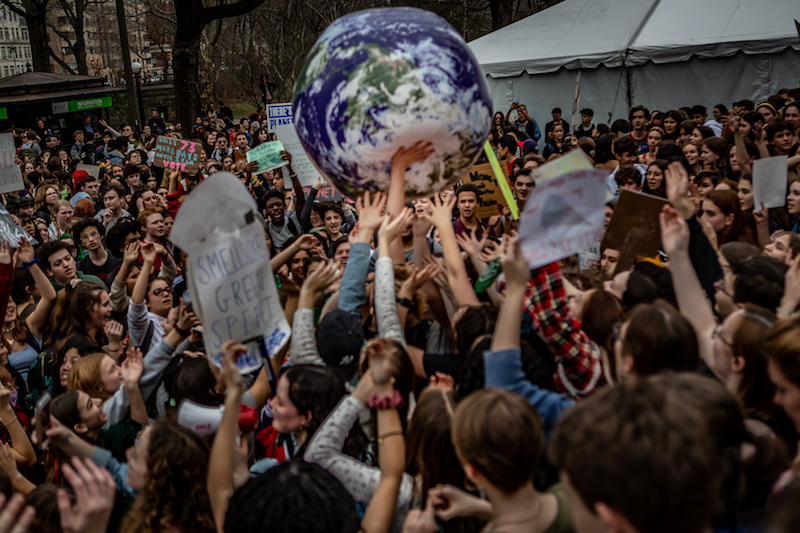As Climate Change Accelerates, So Does Global Hunger, Report Reveals
After years of decline, a warming planet makes food insecurity worse, says the World Meteorological Organization. Climate change protest in New York City in March 2018. (Michael Nigro / Truthdig)
Climate change protest in New York City in March 2018. (Michael Nigro / Truthdig)
The global threat of hunger is growing again after years of progress in reducing it, the United Nations says, because of the effects of climate change.
It says this is just one aspect of a wider acceleration in the pace of the changes wrought by the world’s unremitting consumption of fossil fuels and the consequential rise in global temperatures..
The evidence that hunger and malnutrition are once again on the rise is published in a new report from the World Meteorological Organization (WMO) on the state of the global climate in 2018.
The report, drawing on material from scientists, UN agencies and countries’ own meteorological services, says the physical signs and the impacts of climate change are speeding up as record greenhouse gas concentrations drive global temperatures towards increasingly dangerous levels.
Highlighting record sea level rise and exceptionally high land and ocean temperatures over the past four years, the report warns that this warming trend has lasted since the start of this century and is expected to continue.
Carbon dioxide levels, which were at 357.0 parts per million when the first statement in the series was published in 1994, keep rising − to 405.5 ppm in 2017. Greenhouse gas concentrations for 2018 and 2019 are expected to show a further increase.
The start of 2019 has seen warm record daily winter temperatures in Europe, unusual cold in North America and searing heatwaves in Australia. Arctic and Antarctic ice extent is yet again well below average.
In a statement the UN secretary-general, António Guterres, writes that the data released in the report “give cause for great concern. The past four years were the warmest on record, with the global average surface temperature in 2018 approximately 1°C above the pre-industrial baseline … There is no longer any time for delay.”
Four warming years
The WMO secretary-general, Petteri Taalas, says: “Key findings of this statement include the striking consecutive record warming recorded from 2015 through 2018, the continuous upward trend in the atmospheric concentrations of the major greenhouse gases, the increasing rate of sea level rise and the loss of sea ice in both northern and southern polar regions.”
One particular concern highlighted is food security. In the words of the report, “exposure of the agriculture sector to climate extremes is threatening to reverse gains made in ending malnutrition.
“New evidence shows a continuing rise in world hunger after a prolonged decline, according to data compiled by UN agencies including the Food and Agriculture Organization (FAO) and World Food Programme.
“In 2017, the number of undernourished people was estimated to have increased to 821 million, partly due to severe droughts associated with the strong El Niño of 2015–2016.”
Climate refugees
The FAO says the absolute number of undernourished people − those facing chronic food deprivation − reached nearly 821 m in 2017, from around 804 m in 2016.
The WMO report also singles out the plight of those forced by climate change to leave their homes and become refugees, either within their own countries or abroad. Out of 17.7 m people classified as internally displaced persons (IDPs) tracked by the International Organization for Migration, it says, by September 2018 over 2 m people had been displaced by disasters linked to weather and climate events.
According to the UN refugee agency UNHCR’s Protection and Return Monitoring Network, about 883,000 new internal displacements were recorded between January and December 2018, of which 32% were associated with flooding and 29% with drought.
Hundreds of thousands of Rohingya refugees were affected by what the UN calls “secondary displacement”, caused by extreme events, heavy rain, flooding and landslides.
More acid seas
The WMO also expresses concern about a range of impacts of climate change on the global environment, including reduced levels of oxygen in the oceans. Since the middle of the last century there has been an estimated 1-2% decrease in the amount of oxygen in the world’s oceans, according to UNESCO’s Intergovernmental Oceanographic Commission (UNESCO-IOC).
In the past decade the oceans have absorbed around 30% of CO2 emissions of human origin. Absorbed CO2 reacts with seawater and changes the pH of the ocean. This process, known as ocean acidification, can affect the ability of marine organisms such as molluscs and reef-building corals, to build and maintain shells and skeletal material.
Observations in the open ocean over the last 30 years have shown a clear trend of decreasing pH. In line with previous reports and projections, ocean acidification is ongoing and the global pH levels continue to decrease, according to UNESCO-IOC. One recent report suggested possible alarming future impacts.
The State of the Climate report will be one of WMO’s contributions to the UN’s Climate Action Summit on 23 September.
Your support matters…Independent journalism is under threat and overshadowed by heavily funded mainstream media.
You can help level the playing field. Become a member.
Your tax-deductible contribution keeps us digging beneath the headlines to give you thought-provoking, investigative reporting and analysis that unearths what's really happening- without compromise.
Give today to support our courageous, independent journalists.






You need to be a supporter to comment.
There are currently no responses to this article.
Be the first to respond.